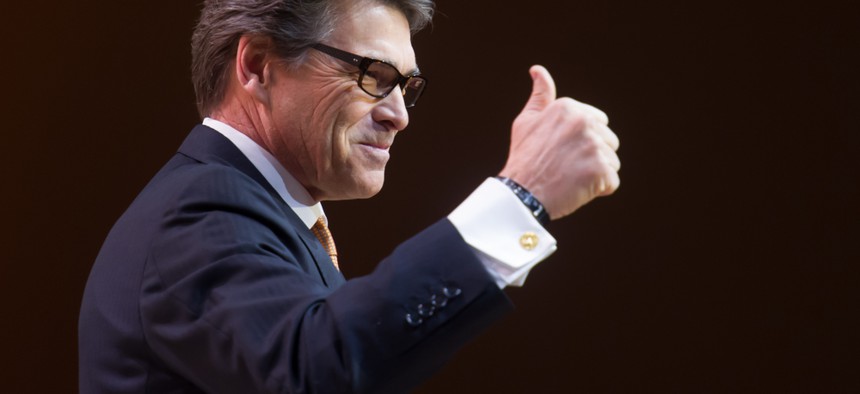Texas Makes a Big Bet on SpaceX

Texas Gov. Rick Perry Christopher Halloran/Shutterstock.com
Is the Lone Star State's astronomical investment a good deal or a boondoggle?
To beat out six other competitors, Texas is putting up $2.3 million in cash and invest $13 million in infrastructure developments to bring a SpaceX launch facility to Brownsville. In return, SpaceX will invest $85 million in the launch facilities and, according to Texas’ governor, Rick Perry, create 300 jobs loading and serving rockets and managing their lift-off.
The Brownsville development will be be SpaceX’s (and Texas’s) only commercial launch facility. SpaceX’s other rockets are launched from pads leased at established US government facilities in Cape Canaveral, Florida, and Vandenberg Air Force Base, in California. The Brownsville location make sense for SpaceX: The city, near the Mexican border, is well-positioned for launches thanks to its equatorial vicinity, which makes it easier to place satellites in geosynchronous orbits, where they are optimally aligned with Earth. Brownsville also is near the Gulf of Mexico, a handy receptacle for used rocket stages to plummet into—at least until SpaceX can get them to land.
In fact, the area is so well-suited that it was the front-runner throughout the selection process. But is this a good bet for Texas?
Spaceports can be a terrible business. Just ask Spaceport America, a Virgin Galactic project that the state of New Mexico has spent $250 million on since 2005—and has yet to see a single launch. The company, affiliated with Richard Branson’s Virgin Group, envisioned a space tourism facility that would create a hub for business in the state. But Virgin Galactic’s technological progress has been slow, the cost of space flight remains high, and the rider experience promised by Virgin Galactic’s SpaceShip Two looks relatively limited. Even when a launch comes (Branson says this year is the year, as he has since 2007) it’s not clear that there will be enough regular demand to bring a meaningful increase in visitors to the area. In other words, it looks like a boondoggle.
When companies use tax dollars to attract business investment, they tend to know what they are getting. But when New Mexico or Texas uses taxpayer dollars to fund spaceports, they are making a bet—that space technology eventually will attract even more economic development to the area, either by making space travel cheap enough to attract hundreds of thousands of tourists or by significantly increasing the volume of the commercial satellite business.
Of the two options, the latter one is by far the more likely—and the former might require the development of something like a space elevator, which would put a decisive end to the whole “using rockets to shoot stuff into space” business model.
That’s why it’s heartening to see that no one involved in the Brownsville facility is talking about tourism. Rather, the focus is on the dozen or so commercial satellite launches that SpaceX could bring to the site each year. Euroconsult estimates that there will be perhaps 350 commercial satellites launched in the next decade, and SpaceX has a launch manifest of 45 flights scheduled through 2018. SpaceX already is demonstrating its efficacy as a low-cost launch provider (it launched a communications satellite for AsiaSat this morning) and if SpaceX’s plan for making its rockets reusable is successful, it should be able to dramatically undercut competitors on cost.
But a failed launch, a lost contract, or trouble from the competition (it ranges from US rivals like the Boeing-Lockheed Martin joint venture ULA and Jeff Bezos’ Blue Origin to firms in Europe and, potentially, China) could leave SpaceX in trouble. If the company fails to meet its potential, all Brownsville might be left with is a bad bet.
(Photo by Christopher Halloran / Shutterstock.com)
NEXT STORY: Turning Civic Interest Into a Call-to-Action






